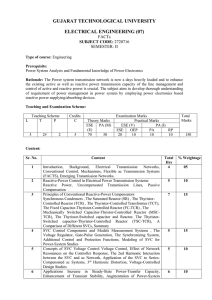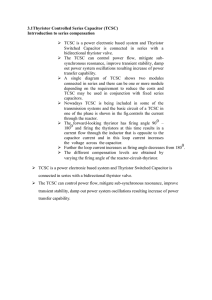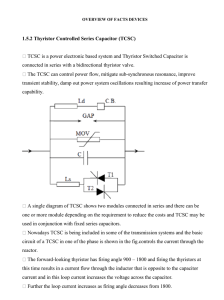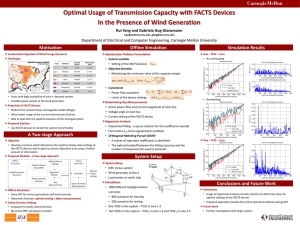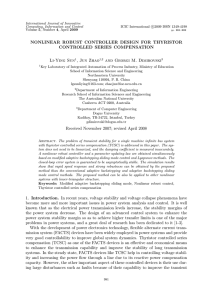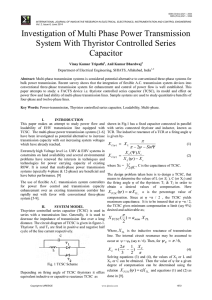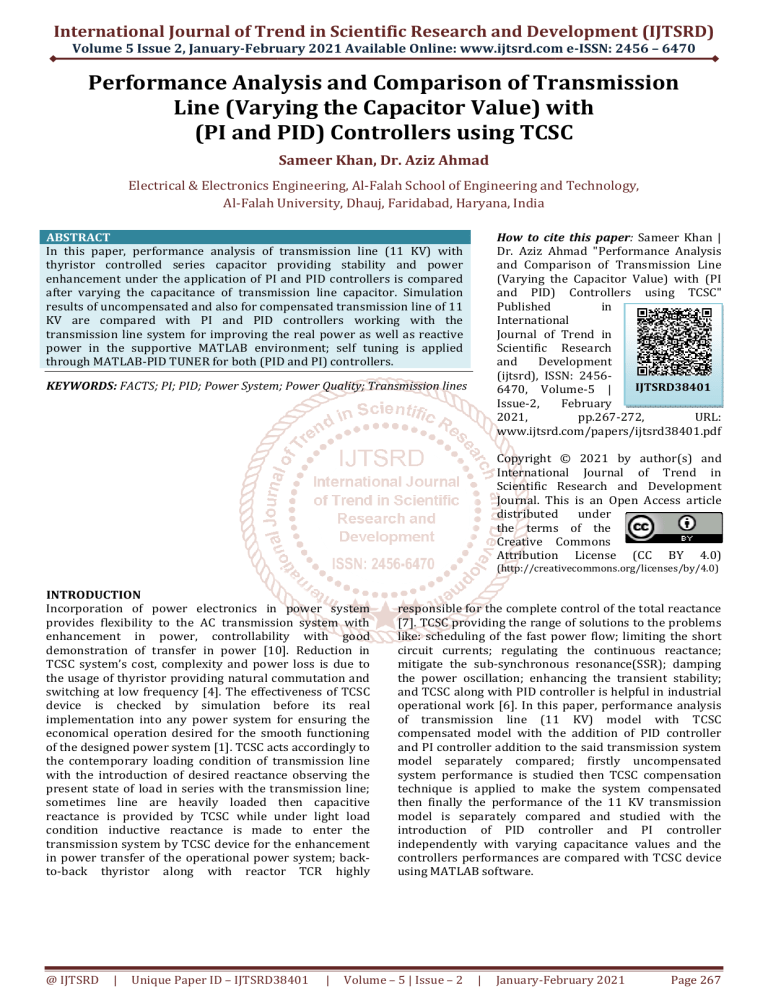
International Journal of Trend in Scientific Research and Development (IJTSRD)
Volume 5 Issue 2, January-February
February 2021 Available Online: www.ijtsrd.com e-ISSN: 2456 – 6470
Performance Analysis and Comparison of Transmission
Line (Varying the Capacitor Value) with
w
(PI and
nd PID) Controllers using
sing TCSC
Sameer Khan, Dr. Aziz Ahmad
Electrical & Electronics Engineering,
Engineering Al-Falah
Falah School of Engineering and Technology,
Al-Falah
Falah University, Dhauj, Faridabad, Haryana, India
How to cite this paper:
paper Sameer Khan |
Dr. Aziz Ahmad "Performance Analysis
and Comparison of Transmission Line
(Varying the Capacitor Value) with (PI
and PID) Controllers using TCSC"
Published
in
International
Journal of Trend in
Scientific Research
and
Development
(ijtsrd), ISSN: 24562456
IJTSRD38401
6470, Volume-5
Volume
|
Issue-2,
2,
February
2021,
pp.267
pp.267-272,
URL:
www.ijtsrd.com/papers/ijtsrd38401.pdf
ABSTRACT
In this paper, performance analysis of transmission line (11 KV) with
thyristor controlled series capacitor providing stability and power
enhancement under the application of PI and PID controllers is compared
after varying the capacitance of transmission line capacitor. Simulation
results of uncompensated and also for compensated transmission line of 11
KV are compared with PI and PID controllers working with the
transmission line system for improving the real power as well as reactive
power in the supportive MATLAB environment; self tuning is applied
through MATLAB-PID TUNER for both (PID and PI) controllers.
KEYWORDS: FACTS; PI; PID; Power System; Power Quality; Transmission lines
Copyright © 2021
20
by author(s) and
International Journal of Trend in
Scientific Research and Development
Journal. This is an Open Access article
distributed
under
the terms of the
Creative Commons
Attribution License (CC BY 4.0)
(http://creativecommons.org/licenses/by/4.0
http://creativecommons.org/licenses/by/4.0)
INTRODUCTION
Incorporation of power electronics in power system
provides flexibility to the AC transmission system with
enhancement in power, controllability with good
demonstration of transfer in power [10]. Reduction in
TCSC system’s cost, complexity and power loss is
i due to
the usage of thyristor providing natural commutation and
switching at low frequency [4]. The effectiveness of TCSC
device is checked by simulation before its real
implementation into any power system for ensuring the
economical operation desired for
or the smooth functioning
of the designed power system [1]. TCSC acts accordingly to
the contemporary loading condition of transmission line
with the introduction of desired reactance observing the
present state of load in series with the transmission line;
line
sometimes line are heavily loaded then capacitive
reactance is provided by TCSC while under light load
condition inductive reactance is made to enter the
transmission system by TCSC device for the enhancement
in power transfer of the operational power system;
sy
backto-back
back thyristor along with reactor TCR highly
@ IJTSRD
|
Unique Paper ID – IJTSRD38401
38401
|
responsible for the complete control of the total reactance
[7]. TCSC providing the range of solutions to the problems
like: scheduling of the fast power flow; limiting the short
circuit currents;
rents; regulating the continuous reactance;
mitigate the sub-synchronous
synchronous resonance(SSR); damping
the power oscillation; enhancing the transient stability;
and TCSC along with PID controller is helpful in industrial
operational work [6]. In this paper, performance
per
analysis
of transmission line (11 KV) model with TCSC
compensated model with the addition of PID controller
and PI controller addition to the said transmission system
model separately compared; firstly uncompensated
system performance is studied then
t
TCSC compensation
technique is applied to make the system compensated
then finally the performance of the 11 KV transmission
model is separately compared and studied with the
introduction of PID controller and PI controller
independently with varying capacitance
c
values and the
controllers performances are compared with TCSC device
using MATLAB software.
Volume – 5 | Issue – 2
|
January-February
February 2021
Page 267
International Journal of Trend in Scientific Research and Development (IJTSRD) @ www.ijtsrd.com eISSN: 2456-6470
TCSC reactance into Inductive region, capacitive region
and in the region of resonance [2].
LITERATURE REVIEW
A. TCSC addition into the transmission system
C. TCSC power controller model with PID controller
Fig.2.PID control diagram to transmission system
Fig.1.TCSC added in the transmission system (a)
Schematic diagram of TCSC (b) TCSC reactance
r
The simple introduction of TCSC into the transmission
system is shown in figure.1 (a). The capacitor series
connection with parallel reactor TCR makes a TCSC
compensated system in which firing angle of thyristor is
adjusted to control TCR [3]. TCR is found in nonnon
conducting state at 180 while at 90 , it comes to full
conduction [3]. In this TCSC device, GTO (Gate turn-off)
turn
thyristor is not required [3]. The impedance of the TCSC
system due to LC circuit is given by equation (1)
α
X
e
P>?@ " PAB.
(10)
-
α T
K D e t E K FH e t dt E K I
IB I-
(11)
Where, proportional, integral, and derivative gains are
written asK D , K and K I respectively [6].
D. TCSC power controller model with PI controller
(1)
α
Figure.2 shows the PID control; In PID controller error
power signal is found by equation (10) to find firing angle
α t as PID output written by equation (11)
Where, XL and XC are the variable inductive reactance and
fixed capacitive reactance respectively and the delay angle
is calculated [10].
X α
X
X
X
π
π
,X
α
α
Fig.3.PI control diagram to transmission system
X α
∞
(2)
Figure.3 shows the PI control of TCSC-PI
TCSC
transmission
system, it changes or controls the TCSC reactance within
as written by equation (12) with reference power as P>?@
and line power asPJ B [9].
(3)
ω
π
ω
2πfL
(4)
From [10], transmission line compensation (percentage) is
given by equation (5)
100
(5)
B. Operational parameters of TCSC
TCSC injects a variable reactance
in the transmission
line as given by equation (6)
#$
!1 "
COS
/σ
$
σ , -.
-.
#$
σ
$
π
%&
%
'
+
(# $
#$
]
λ
K is equal to
λ is equal to
ω
|
Unique Paper ID – IJTSRD38401
38401
|
(12)
X
jX
(13)
j
>
π
π α &
α
"jX
(14)
(15)
Z /Z
π
< Represents the cyclic portion of thyristor which is in
operation state and being the function of XTCSC, divide the
@ IJTSRD
>
=jS
(9)
√
Z
Z
(8)
B
jX
Z
(7)
K LM
S) P>?@ PJ
MODELLING
A. TCSC DEVICE
Figure.1 shows the addition of TCSC device in
transmission system; the impedance provided by TCSC is
given by equation (13) equation (14) represents the
impedance of the reactor, equation (15) tells about the
impedance of capacity, equation (16)
(1 and (17) state the
relationship between the impedances of capacity and
reactor and finally equation (18) describes reactance of
TCSC with firing angle from [5].
Z
(6)
Where, the values of σ, K and λ are given by equations (7),
(8) and (9) respectively.
σ is equal to 2 π " α
KK E
X
π α&
>
=
P
P
P Q R
&P Q R
(17)
α
(α = S
π
Volume – 5 | Issue – 2
π α &
|
(16)
α
January-February
February 2021
(18)
Page 268
International Journal of Trend in Scientific Research and Development (IJTSRD) @ www.ijtsrd.com eISSN: 2456-6470
B. Power analysis (for P and Q) of transmission line
system
A. Compensated TCSC transmission line system
model
Fig.4. Mounting of TCSC device in transmission line
system
Figure.4 representing the implementation of TCSC in
transmission line, equation (19), (20), (21) and (22)
represent the value of real power (P12), reactive power
(Q12), line reactance (XLINE), and TCSC reactance (XTCSC)
respectively.
TU T$
P
Q
X
X
VU$
=
B
(19)
Q W
T$ $
TU T$
VU$
Y δ
Q W
X
E X
K
X
(20)
Fig.9.Compensated TCSC system model
The TCSC transmission (11 KV) system model used for
providing compensation is displayed in figure.9, system
stability is maintained by the fixed value of TCR (100 mH)
while the real and reactive power flows are carried out
with capacitance = 350Z[ in compensated TCSC system
models as well as TCSC (including PID and PI controller)
transmission line models also and simulation results for
compensated system model are shown as below:
(21)
B
(22)
TCSC changes power flow of the system with changing its
capacitive reactance setting [8].
Fig.10.Sending (voltage and current) from supply of
compensated
sated TCSC system
PERFORMANCE
ANALYSIS
OF
THYRISTOR
CONTROLLED SERIES CAPACITOR (TCSC) DEVICE
A. Uncompensated (without TCSC) system model
Fig.11.Receiving (voltage and current) at load of
Compensated TCSC system
Fig.5.Uncompensated system model
Figure.5 shows the uncompensated system with the
source [Phase (deg) = 0, Source Impedance of
(0.01+0.001) ] and Line Impedance of (5+0.023)
provided while load parameters are 25MW and 50 MVAR
for the system. Voltage and current (sending as well as
receiving) and power flows from simulation (using
MATLAB-SIMULINK)
SIMULINK) are presented in figure 6, figure 7,
and figure 8 respectively:
Fig.6.Sending (voltage and current) from supply of
uncompensated system
Fig.7.Receiving (voltage and current) at load of
uncompensated system
Fig.8.Power curves of uncompensated system model
@ IJTSRD
|
Unique Paper ID – IJTSRD38401
38401
|
Fig.12. Power curves of compensated system mode
Table I Power flow presentation for TCSC
compensated transmission (11 KV) system
Capacitor
P (in
Q
S.NO
Value (in
mega
(in mega volt
micro farad)
watt)
ampere reactive)
1.
50
0.88
1.77
2
200
1.02
2.05
3.
350
1.19
2.39
4.
500
1.41
2.82
5.
600
1.57
3.15
6.
800
1.97
3.99
7.
1000
2.49
5.01
8.
1200
3.10
6.24
9.
1400
3.72
7.52
10.
1500
3.94
7.93
The power flows have been improved from (0.88 to 3.94)
MW (P) and (1.77 to 7.93) MVAR (Q) respectively by
varying the capacitance in the range (50 to 1500) μF for
the stable operation of the transmission system model as
shown in table.I. The same range of capacitance is used for
both (PID and PI) controller system of transmission line.
The firing angle of 90 is used for triggering the thyristor
Volume – 5 | Issue – 2
|
January-February
February 2021
Page 269
International Journal of Trend in Scientific Research and Development (IJTSRD) @ www.ijtsrd.com eISSN: 2456-6470
T1 and it is also applicable for both the system models
comprising of PID and PI controller.
PERFORMANCE ANALYSIS OF COMPENSATED TCSC
TRANSMISSION LINE (11 KV) SYSTEM MODEL (with
PID CONTROLLER)
Fig.13. Compensated TCSC system model with PID
controller
The compensated TCSC transmission line system model
with PID controller is shown in figure.13. The Function
Block Parameter: Gain = -1 at (P= 0, I= -1,
1, D = 0) selected
for obtaining the results. PID controller based TCSC
system model simulation results are as below:
TABLE II Power flow presentation by TCSC-PID
TCSC
compensated transmission (11 KV) system
Capacitor
P (in
Q (in mega volt
S.NO
Value (in
mega
ampere reactive)
micro farad)
watt)
1.
50
1.028
1.905
2
200
1.042
2.066
3.
350
1.21
2.399
4.
500
1.438
2.829
5.
600
1.587
3.161
6.
800
2.008
3.975
7.
1000
2.56
5.018
8.
1200
3.12
6.228
9.
1400
3.709
7.47
10.
1500
3.905
7.961
The real (P) and reactive power (Q) flows have shown
improvement from (1.028 to 3.905) MW and (1.905 to
7.961) MVAR, respectively in the range of capacitance
from (50 to 1500) F as shown in table.II.
PERFORMANCE ANALYSIS OF COMPENSATED TCSC
SYSTEM MODEL (WITH PI CONTROLLER)
Fig.14.Sending (voltage and current) from source of
TCSC-PID
Fig.15.Receiving (voltage
tage and current) at load of TCSCTCSC
PID
Fig.18.Compensated TCSC system model with PI
controller
Compensated TCSC model with PI controller is shown in
figure.19. The Function Block Parameter: Gain = -1 at (P=
0, I= 1, D = 0) selected for obtaining the results.
Fig.19.
.19. Sending (voltage and current) from source of
TCSC-PI
PI system
Fig.16.Close Loop Snapshot Linearization for
compensated TCSC-PID
PID system model
The closed loop snapshot linearization for TCSC-PID
TCSC
transmission line (11 KV) system model is given in
figure.16 is selected for the system model to study the
performance of the given transmission system model.
Fig.20.Receiving (voltage and current) at load of TCSCTCSC
PI system
Fig.17.Power curves for compensated TCSC-PID
TCSC
system model
Fig.21.Close Loop Snapshot Linearization for
compensated TCSC-PI
TCSC
system model
@ IJTSRD
|
Unique Paper ID – IJTSRD38401
38401
|
Volume – 5 | Issue – 2
|
January-February
February 2021
Page 270
International Journal of Trend in Scientific Research and Development (IJTSRD) @ www.ijtsrd.com eISSN: 2456-6470
The close loop snapshot linearization for TCSC-PI
transmission line (11 KV) system model in figure.21.
B. Compensation of transmission line (11 KV) system
using TCSC (with PID) controller
Fig.22. Power curves for compensated TCSC-PI system
Fig.24. Variation of power flow of TCSC-PID
compensated system within the range of capacitance
(50 to 1500) _`
Table III Power flow presentation for TCSC-PI
compensated transmission (11KV) system
Capacitor
P (in
Q (in mega
S.NO
Value (in
mega
volt ampere
micro farad)
watt)
reactive)
1.
50
0.886
1.77
2
200
1.033
2.069
3.
350
1.2
2.4
4.
500
1.416
2.825
5.
600
1.586
3.163
6.
800
1.975
3.988
7.
1000
2.499
5.018
8.
1200
3.092
6.227
9.
1400
3.723
7.429
10.
1500
3.94
7.895
Figure.24 shows the improvement in reactive power with
increasing capacitance. It is found that the transmission
system containing TCSC with PID controller gives better
performance than the transmission system using TCSC.
C. Compensation of transmission line (11 KV) system
using TCSC (with PI) controller
The TCSC compensated transmission line system with PI
controller provides improvement in real and reactive
power flows from (0.886 to 3.94) MW and (1.77 to 7.895)
MVAR respectively as shown in table.III.
RESULTS
A. Compensation of transmission line (11 KV) system
using TCSC
Fig.25. Variation of power flow of TCSC-PI system
within the range of capacitance (50 to 1500) ]^
Figure.25 shows the improvement of reactive power with
increasing the capacitance of transmission line system.
The TCSC-PI transmission line system is performing best
at 1500 μF of the capacitor.
Fig.23. Variation of power flow of TCSC compensated
system within the range of capacitance (50 to 1500)
]^
TABLE IV Comparison of power flows between
transmission line (11 KV) systems using TCSC with
(PID and PI) controllers
Transmission
Capacitance
Capacitance
(350 _`
(1500 _`)
System
Real
Reactive
Real
Reactive
Device
Power
Power
Power
Power
(Mw)
(Mvar)
(Mw)
(Mvar)
TCSC
1.19
2.39
3.94
7.93
TCSC-PID
1.21
2.399
3.905
7.961
TCSC-PI
1.2
2.4
3.94
7.895
The compensation of the transmission line after varying
capacitor values of TCSC connected system results in the
improvement of reactive power with increasing
capacitance value is shown in figure.23.
@ IJTSRD
|
Unique Paper ID – IJTSRD38401
|
Volume – 5 | Issue – 2
|
January-February 2021
Page 271
International Journal of Trend in Scientific Research and Development (IJTSRD) @ www.ijtsrd.com eISSN: 2456-6470
TCSC and TCSC-PID controller provides the most desirable
performance at 350 μF while TCSC-PI is performing best at
1500 μF capacitance of compensated transmission system.
REFERENCES
[1] Martin German Sobek, Lubomir Bena, Roman
Cimbala, “Using of the Thyristor Controlled Series
Capacitor
in
Electric
Power
System”,
ELEKTROENERGETIKA Vol. 4; (2011).
Fig.26.Representation of power flows variation of
different transmission (11KV) compensated systems
within the range of capacitance (50 to 1500) _`
Variation of power flow of different transmission line
systems is shown in Figure.27 shows the variation of
power of different systems. At 1500μF, TCSC-PI
compensation is providing best power flow while at 350μF
TCSC-PID and TCSC compensation performing well in the
transmission system.
CONCLUSION
The comparative study of transmission line (11 KV)
system model and simulation with TCSC, PID and PI
controller is
done
through MATLAB-SIMULINK
environment. This paper presents performance analysis of
the transmission line (11 KV) system model using TCSC
with (PID and PI) controllers and an elaborate comparison
between their performances. Results show that TCSC,
TCSC-PID and TCSC-PI compensated transmission line
system model, reactive power flow is improved by
increasing capacitance than uncompensated transmission
system and it displays max value at capacitance (1500μF ).
The function block parameter gain is fixed at -1, helped to
make comparison between PID and PI controller installed
on transmission system and reciprocal value of I
parameter from both PID as well as PI controller to each
other found useful to make the thyristors operational to
utilize the full complete range of capacitances used in the
system and it will be helpful to operate the transmission
system within all capacitance values with both controller
taken into consideration for economical operation in any
power system for future work . The addition of TCSC with
PI and PID controller into the transmission line not only
improved the power flows but also enhanced the power
quality of the transmission system also as compared to the
uncompensated transmission system. Hence it can be
concluded that transmission line (11 KV) system using
@ IJTSRD
|
Unique Paper ID – IJTSRD38401
|
[2]
M. Zellagui1, A. Chaghi2; “Impact of TCSC on
Measured Impedance by MHO Distance Relay on 400
KV Algerian Transmission Line in Presence of Phase
to Earth Fault”, J. Electrical Systems 8-3 (2012):
273-291.
[3]
Samima Akter1, Anulekha Saha2, Prof. Priyanath
Das3, “Modelling, Simulation and Comparison of
Various FACTS Devices in Power System”, IJERT, Vol.
1 Issue 8, October – 2012.
[4]
M. Nayeripour1, M. Mahdi Mansouri2, “Analyze of
Real Switching Angle Limits in TCSC on Capacitor
and Inductor Values and their Selection Factors”,
IJAST Vol. 57; August (2013).
[5]
H. Guentria1, F. Lakdjaa2, M.Laouera3, “The
opportunity of power electronics on improving the
quality of voltage and power flow in the west Algeria
network”, Energy Procedia, 50 (2014) 870 – 881.
[6]
Mohsen Hosseinzadeh1, Soreshjani2, Navid Reza
Abjadi3, Abbas Kargar4, Gholamreza Arab
Markadeh5, “A comparison of fuzzy logic and PID
controllers to control transmitted power using a
TCSC”, Turk J Electrical Engineering & Comp Science
(2014) 22: 1463 – 1475.
[7]
D. Chatterjee1, A. Mitra2, S. Sarkar3, “A Conceptual
Study for Control Strategy of TCSC in Inductive and
Capacitive Region”, ICCPCT, (2014).
[8]
Lazhar
Bougouffa1,
Abdelaziz
Chaghi2,
“Investigation of TCSC controller effect on IDMT
directional over current Relay”, Procedia – Social
and Behavioral Sciences 195 (2015) 2421 – 2429.
[9]
M. Dilip Kumar1, P.Sujatha2, “Design and
Development of Self Tuning Controller for TCSC to
Damp Inter Harmonic Oscillation”, Energy Procedia,
117 (2017) 802- 809.
[10]
Niraj H. Patel1, Raju B. Chaudhary2, Rozina R.
Surani3, Hemant N. Raval4, “TCSC – Modeling and
Operation”, IJAERD Volume 4, Issue 5, May (2017)
Volume – 5 | Issue – 2
|
January-February 2021
Page 272


